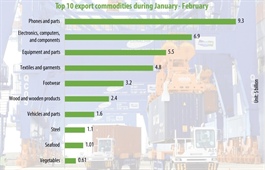Moody's lifts Vietnam's outlook to positive
Moody's lifts Vietnam's outlook to positive
Credit rating firm Moody's has upgraded Vietnam's outlook from negative to positive thanks to improvements in fiscal strength and the global manufacturing shift to the country.
A Moody's sign is displayed on 7 World Trade Center, the company's corporate headquarters in New York, February 6, 2013. Photo by Reuters/Brendan McDermid.
|
Sustained fiscal consolidation has led to improvements in fiscal and debt metrics, which Moody's expects to be only briefly interrupted by the pandemic.
Vietnam's economic strength could continue to benefit from global shifts in production, trade and consumption following the coronavirus pandemic, it said.
As companies aim to diversify their production locations in Asia, Vietnam would continue to attract foreign direct investment due to competitive labor costs, political stability and incentives for trade and investment, it said.
The recent free trade agreements it has signed should firm up the country’s "competitive position in lower value products such as footwear and garments" while placing it at the center of higher-value-added regional tech supply chains for smartphones, semiconductors and other electronic products, it forecast.
In December 2019 Moody's gave Vietnam a negative outlook due to delays in paying government guaranteed debt.
But it has decided to change the outlook now after the government enhanced scrutiny of payments.
The government has been monitoring the list of direct and indirect debt obligations, and instituted an administrative process whereby relevant ministries set aside funding in advance to fulfill these obligations, Moody's said.
It said it would consider downgrading Vietnam's rating if there is a reemergence of financial instability, leading to higher inflation, a rise in debt-servicing costs or a worsening of the country's external payments position.
The country’s rating remains at Ba3 (non-investment grade) as there are ongoing risks stemming from persistent governance weaknesses related to the lack of transparency in managing state-owned enterprises and lingering risks in the banking system.




























